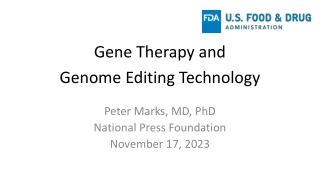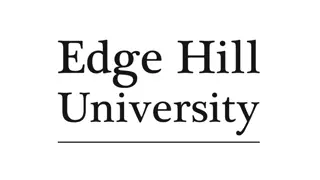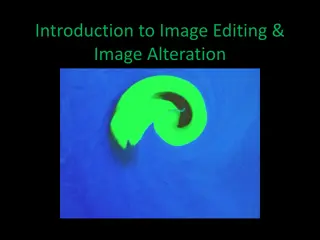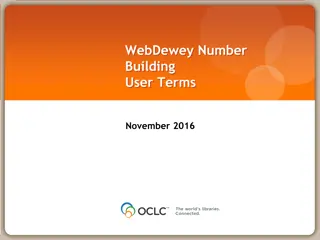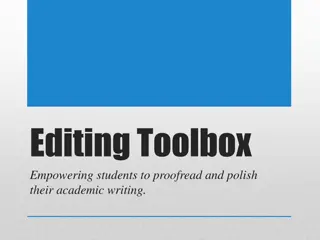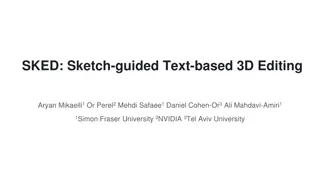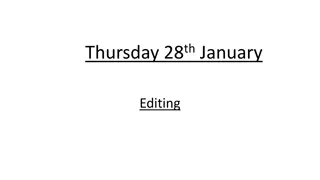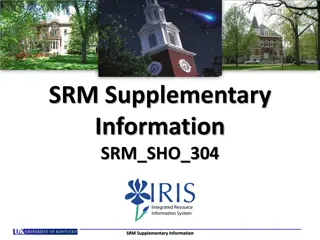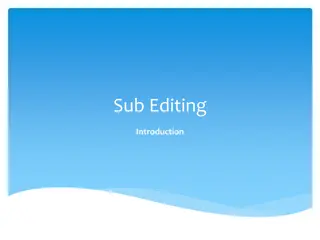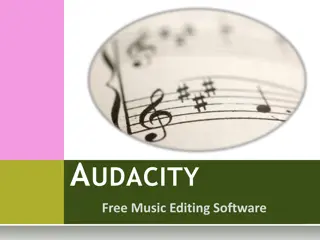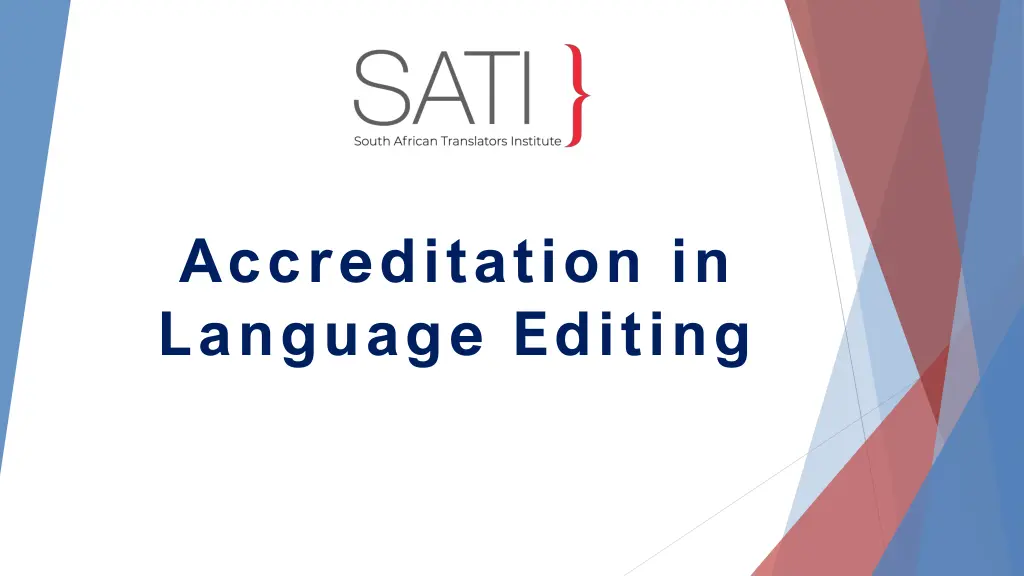
Accreditation in Language Editing Requirements
Learn about the prerequisites and process for obtaining accreditation in language editing, including membership requirements, practice tests, examination details, waiting periods, and preparation tips.
Download Presentation

Please find below an Image/Link to download the presentation.
The content on the website is provided AS IS for your information and personal use only. It may not be sold, licensed, or shared on other websites without obtaining consent from the author. If you encounter any issues during the download, it is possible that the publisher has removed the file from their server.
You are allowed to download the files provided on this website for personal or commercial use, subject to the condition that they are used lawfully. All files are the property of their respective owners.
The content on the website is provided AS IS for your information and personal use only. It may not be sold, licensed, or shared on other websites without obtaining consent from the author.
E N D
Presentation Transcript
Accreditation in Language Editing
Prerequisites Active and paid SATI membership of at least three months (student membership does not qualify), plus A post-secondary language practice qualification plus evidence of at least three years language practice work in editing (with professional references) If the applicant does not have a post-secondary language practice qualification, evidence of at least five years language practice work in editing (with professional references) will be required. OR Current SATI accreditation OR Membership or current accreditation by a FIT member association accepted by the SATI Council 50 EDITING Presentation
Practice Test If you feel unsure, you can first write an optional practice test in editing before proceeding to the actual examination. This is a short test to give you an idea of what the examination would be like. Writing and passing the practice test is not a prerequisite to qualify for the actual examination. It is recommended, though, as it can give candidates an idea of whether they are likely to pass the examination or not. However, passing the practice test is not a guarantee that the examination itself will be passed. 50 EDITING Presentation
Differences between Practice Test and Examination Practice Test 1 text 3 months' time limit Marked by 1 examiner Test paper is sent back with marks and a report Examination 6 texts (chosen from 12) 24 hours Marked by 2 examiners Complete report is sent back 50 EDITING Presentation
Waiting Periods Depending on the outcome of the practice test, the following waiting periods apply for proceeding to the accreditation examination in editing: - No major errors and up to 8 minor errors: 3 months - No major errors and more than 8 minor errors: 6 months - One or more major errors and up to 5 minor errors: 6 months - One or more major errors and more than 5 minor errors: 8 months 50 EDITING Presentation
Preparing for the exam The SATI examination in editing is designed for candidates who are already experts and seasoned language editors and would like to add SATI accreditation to their qualifications. SATI does not train translators and we do not offer preparation material to prospective candidates. 50 EDITING Presentation
Venue and Date - A suitable date and time is agreed with the Accreditation Officer - On said date and time, the candidate will receive the password-protected examination documents via email - The candidate must complete and return the documents within 24 hours - Candidates must complete a Solemn Statement declaring that the translation is their own work - If any of these conditions are not complied with, the examination will be declared null and void, the examination fee will be forfeited, and the candidate will have to wait 12 months before they may apply again 50 EDITING Presentation
Documents The examination contents will be provided via email to the candidate on the day of the exam. The candidate should edit six texts. There will be a choice of twelve texts, which cover a variety of subjects. Editing may be done using a pen (by hand) on the printed texts OR electronically with track changes. If a candidate is unsure about using track changes, they may ask the exam officer for guidelines prior to the examination date. 50 EDITING Presentation
Tips When writing your examination, we recommend to: - Read through all the texts before deciding which ones to edit - Read the instructions carefully - Analyse each text for tone, register, style, emphasis, context, etc. - Plan time carefully - Use double spacing and font size 12 in Calibri or Times New Roman - Use a spellchecker and proofread carefully for typos, extra spacing and other odd formatting - If editing in English, always use English (UK) 50 EDITING Presentation
Resources The following resources are allowed and recommended when writing the examination: - A spellchecker for the target language - Any dictionaries, glossaries, wordlists, reports, grammar guides, thesaurus and books on language - Internet resources 50 EDITING Presentation
Assessment procedure The examination in editing is marked by two examiners. They do not have contact with each other, and the candidate remains anonymous. These examiners are professional, experienced and accredited editors. The final result is approved by the SATI Council. 50 EDITING Presentation
Error types The following are considered MAJOR ERRORS: - Producing misleading / unclear text - Changing the meaning of the original - Deleting essential information - Inserting unnecessary information - Introducing / not correcting errors of grammar/syntax - Introducing / not correcting spelling errors that would be picked up by a spellchecker - Introducing / not correcting inconsistencies - Not adhering to accepted conventions 50 EDITING Presentation
Error types The following are considered MINOR ERRORS: - Introducing / not correcting errors that render the text inelegant without affecting the message - Not correcting spelling errors that would be picked up by a spellchecker 50 EDITING Presentation
Failing The following number of errors will result in a fail: - Two or more major errors in one question or - Five or more minor errors in one question or - Five or more major errors overall or - Ten or more minor errors overall 50 EDITING Presentation
Other Candidates are allowed to use annotations (footnotes) to communicate with the examiner, for instance to explain a particular decision. However, annotations should be used sparingly. 50 EDITING Presentation
Results The examination's assessment can take up to six weeks. Candidates will receive a report with a selection of examiners comments. Note: - Not all errors will be listed in the report - Candidates will not see their marked scripts - Candidates cannot discuss their results with the accreditation officer 50 EDITING Presentation
Accreditation certification Successful candidates: - will receive an accreditation certificate - will be listed on SATI s website as accredited members - may use their accreditation status in communication with clients, e.g in an email signature 50 EDITING Presentation
Unsuccessful result If a candidate fails to meet the required standard for accreditation in editing on the day of the examination, they may apply to re-take the exam after one year. The candidate should read the comments carefully and follow the advice given. 50 EDITING Presentation
Appeal A candidate who wants to lodge an appeal should submit the application form and proof of payment within 8 weeks after having received the result. The original examination script will be marked by a third examiner and that report will be the final result. No further correspondence will be entered into after the final result is made available. If the Fail result is overturned, the candidate will be refunded for the appeal and will be considered accredited in editing. 50 EDITING Presentation
Accreditation validity Accreditation practitioner remains a member of SATI. remains valid as long as the language Accreditation practitioner wish to become re-accredited, they will have to re-apply to do the examination and pass it again. lapses when membership lapses. Should the 50 EDITING Presentation
For more info, please email SATI's Accreditation Officer Erica du Preez: accreditation@translators.org.za

